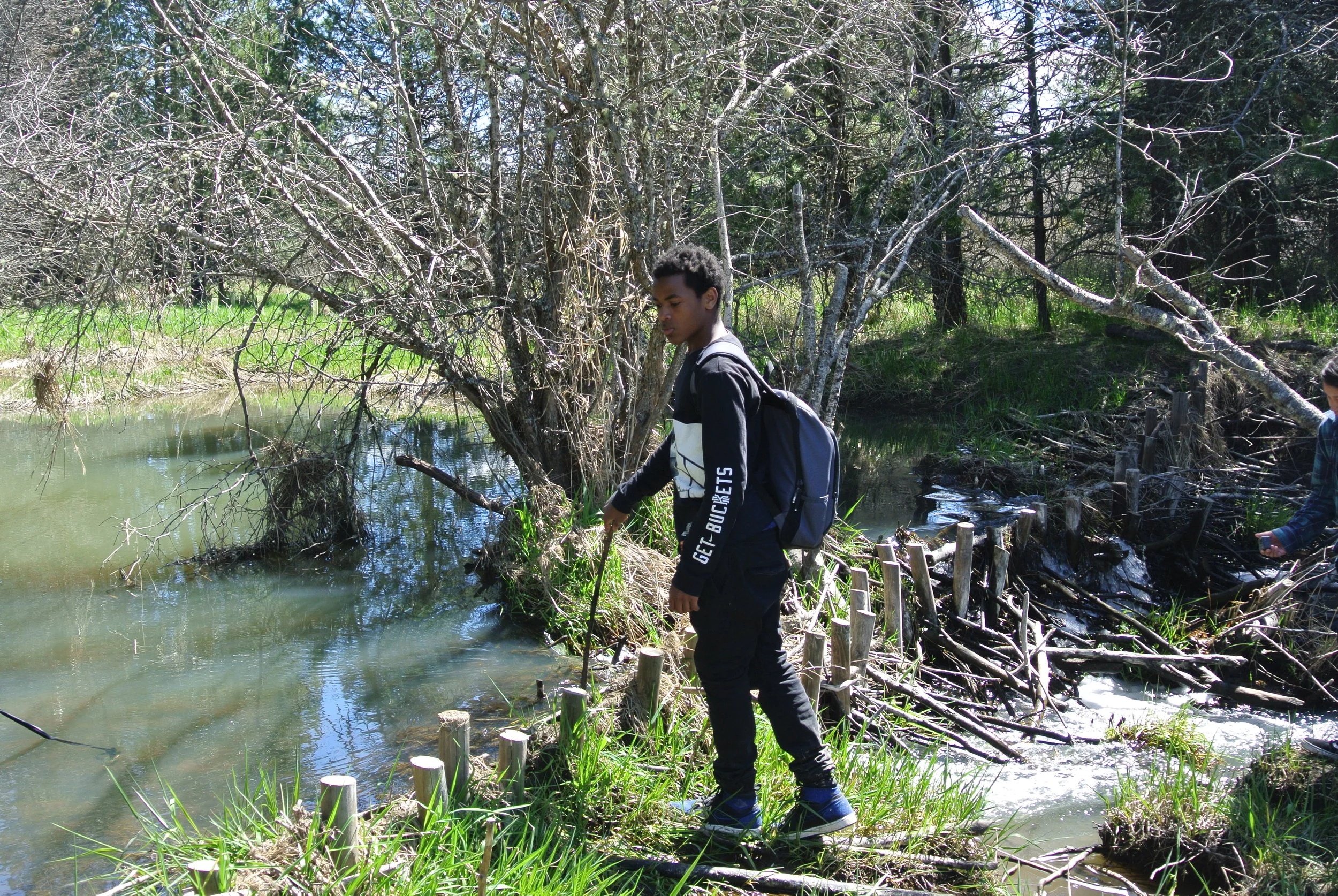(note from the editor: scroll to the bottom for a bonus video by Cutboard Studio!)
What does a bunch of kids running up a wheat field in the Palouse have to do with beavers and Hangman Creek? Here’s what.
We offered up the opportunity to teach a bunch of 9th graders at Pride Prep about why beavers are essential to restoring the headwaters of Hangman Creek, and they jumped at the chance.
Students hiked up the hill for a view of the landscape.
After driving almost 60 miles though the Palouse wheat fields, from Spokane to Sanders Idaho, we arrived at our first stop in the headwaters of Hangman Creek. We were met by our primary tour guide, Gerry Green, Restoration Ecologist with the Coeur d’Alene Tribe Wildlife Program. Also along to contribute were dedicated “beaver believers” Ben Goldfarb (author of Eager: the surprising and secretive life of beavers and why they matter) and Joe Cannon, restoration ecologist with The Lands Council. These kids were prepared! They’d already studied Hangman Creek, knew why and how it got to be polluted, and they’d read parts of the beaver book.
Jerry Green explains the importance of how floodplains allow a river to meander.
At this first stop, we hiked a quarter mile along an old road to a small bridge over Hangman Creek. Here, Gerry takes out a staff gage to measure the depth of the water in the creek. He explains what a flood plain is, where the water comes from in this area, how the flood plain has been altered, and how the alterations in the flood plain have damaged Hangman Creek. Most of the kids are riveted. It’s easy to see why: Gerry’s dedication to this project is obvious – he’s been working for over 20 years to attract beavers, who will build dams, impound water, improve water quality and quantity so that Redband trout can survive. The ultimate goal is to restore salmon into this watershed.
Lunch break with author Ben Goldfarb.
At this stop we learn about infrastructure. The bridge we’re standing on causes a constriction in the flow of water, so that all the water flows under the bridge. All the water flowing to one spot has injured the creek and caused the water to gouge out a very deep channel. Plus, there’s a power line under the creek. The bridge and the power line are essential, and are excellent examples of how even very simple infrastructure can damage a creek and flood plain. We discuss options for fixing this problems, and the kids have some good ideas!
Students walk along the restored headwaters of Hangman Creek.
We hiked a little further upstream to our lunch spot. Here, a group of students talk to Ben about beavers. How often do students get to have quality time with a professional journalist and author? The kids were rapt. No wonder!
After lunch, we hiked along a section of Hangman Creek where Gerry and the Coeur d’Alene Tribe have been working for 20 years. The creek used to run in a straight channel here. That has been filled, and the creek allowed to occupy its original meandering path. Seedlings have been planted: cottonwood, alder, and willow – food for beaver. This process works: by planting food for beavers, they will come. Adding beavers to this stream helps slow down creek flow, improves habitat, and benefits the reintroduction of native fish species.
Our hike ends at this beaver dam. It’s easy to see how the dam has caused water to pond upstream, slowing it down, and enabling groundwater recharge. The dam also acts as a filter, allowing sediment to settle behind the dam. Wetland species thrive here, creating even more beaver food, and habitat for birds and amphibians. Beavers need impounded water and ponds for safety. If caught on land by a predator (dogs, wolves, coyotes, humans, bears, and cougars) they can be easily killed. After all, on land they are just “slow, smelly, packages of meat” says Ben. In the water, they are fast swimmers, and can easily escape harm.
Students learned about the benefits of beavers and their dams on the water quality of Hangman Creek.
This dam has been reinforced with wood poles so that it can withstand high flows. Although work in this area started 20 years ago, water levels are not yet stable. A big rain event can damage new beaver dams, but with this kind of reinforcement, they remain in the landscape for longer. The Tribe is hopeful that more beavers will come, and by letting beavers do the work, the habitat in the headwaters of Hangman Creek will continue to improve.
At the end of the day, we loaded back up into the bus, drove through the immense wheat fields of the Palouse, and back to Spokane. We learned so much, and we’re very thankful to the Coeur d’Alene Tribe, and to all that are working to restore Hangman Creek.
Ending the tour with a run up and down a hillside of the Palouse.
The Spokane Riverkeeper toured the Hangman Creek watershed with Ben Goldfarb, Innovate Charter School, and the Coeur d'Alene Tribe to learn about the amazing work beavers can do to restore a landscape and watershed.







